Version 1.1 introduces a practice mode.
This exercise mode can optionally be switched on or off. After installing FracEx Calc, this mode is turned off by default.
Switch on Exercises-Mode
Switching Exercises mode on or off is done under the Settings:
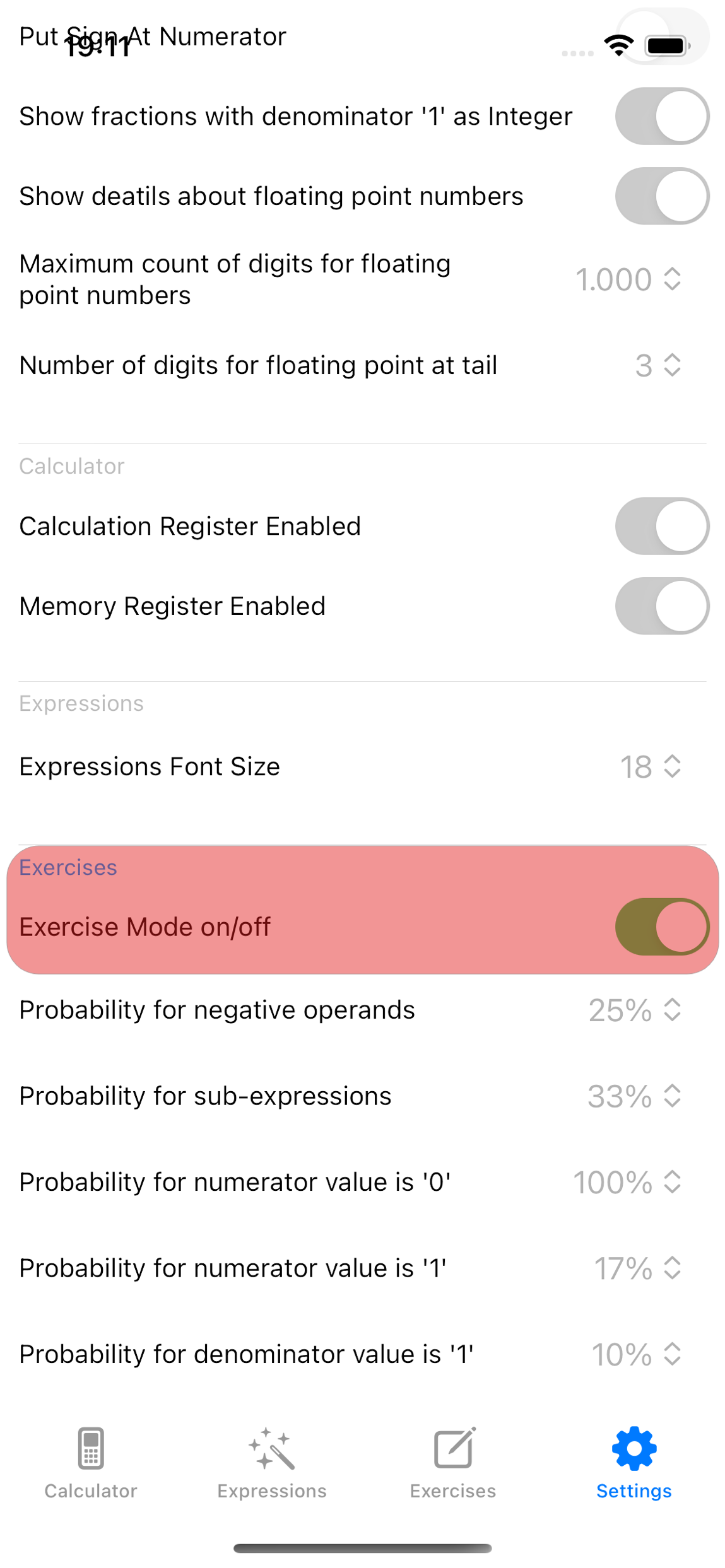
When Exercises mode is switched on, an additional symbol appears in the Navigation TabBar.
This symbol switches to Exercises mode.

In Exercises mode, the definition is made first
After changing the level of difficulty or number of exercises, [Create exercises] must be pressed before the list of exercises gets (re)generated according to these settings.
An advisory text indicates this after changing one of these two settings.
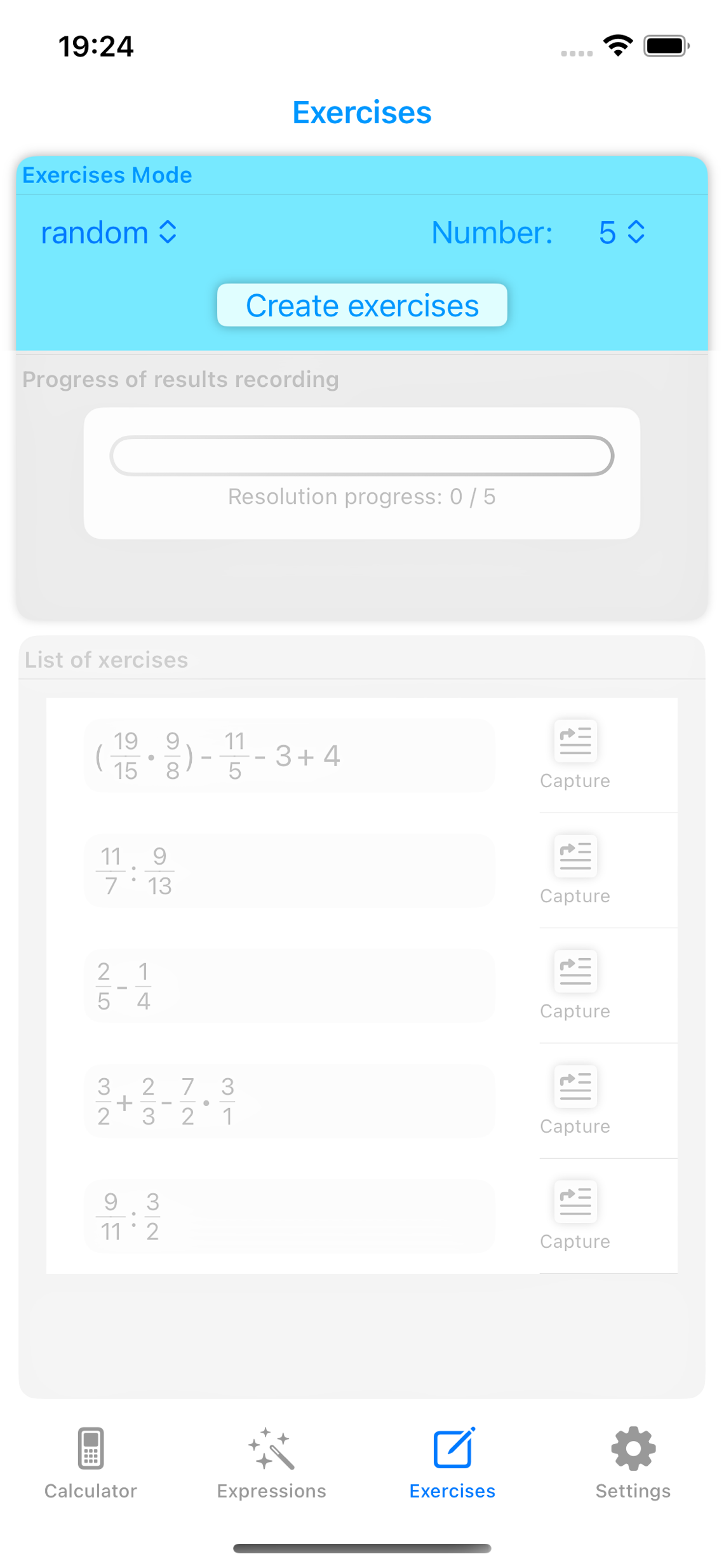
After creating the exercises, the list of exercises is displayed in the lower part.
If the list is longer than can be displayed on the screen, you can scroll through the list. This is usually the case with more than 5 exercises.
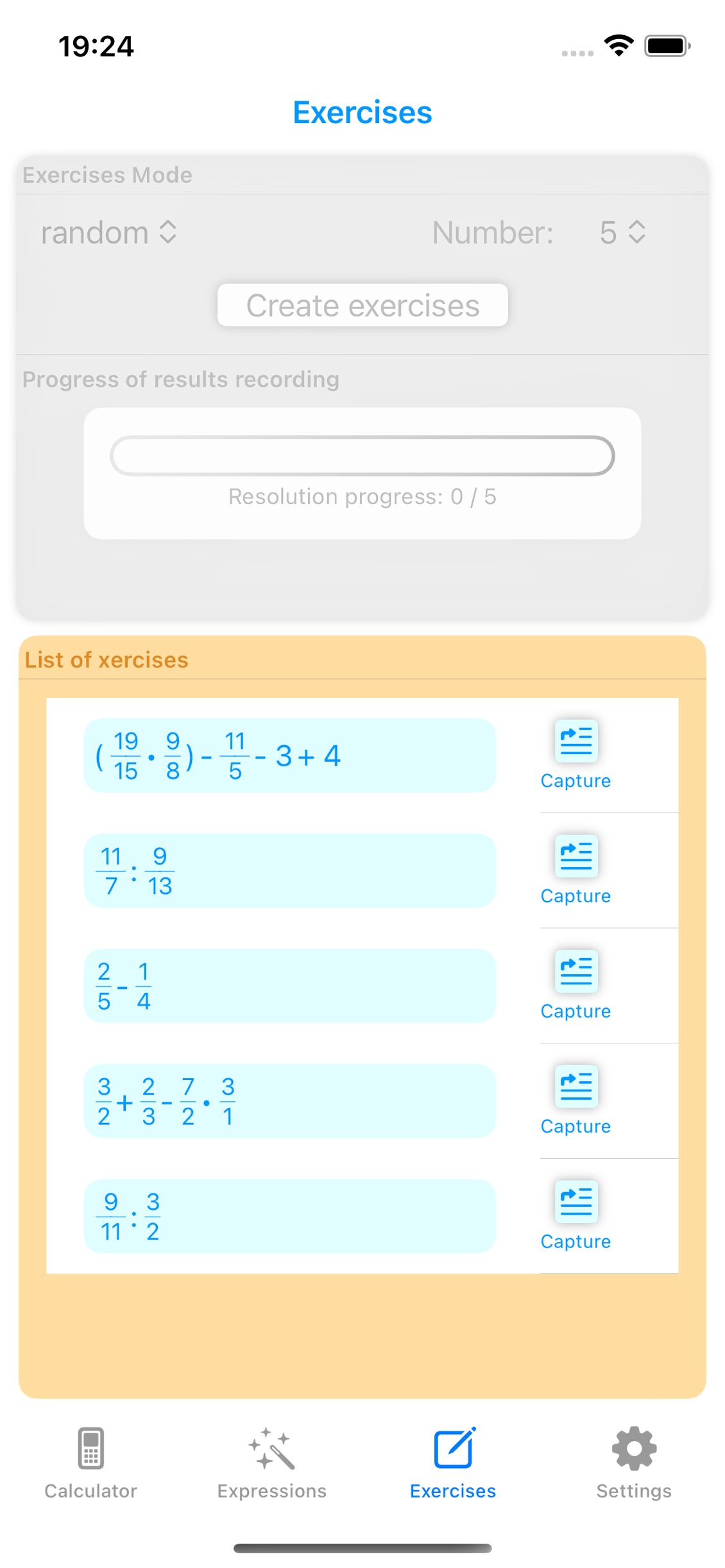
To each exercise in the list is assigned a symbol with the following meaning:
Symbols in the List of Exercises

Result is still to be recorded. If you select it, you will go to the capture screen.

The result is recorded and correct. When you select it, you switch to the results display.

The result is recorded and correct, but not shortened. When you select it, you switch to the results display.

The result is recorded but incorrect. When you select it, you switch to the results display.
Before the result can be recorded, it must first be calculated.
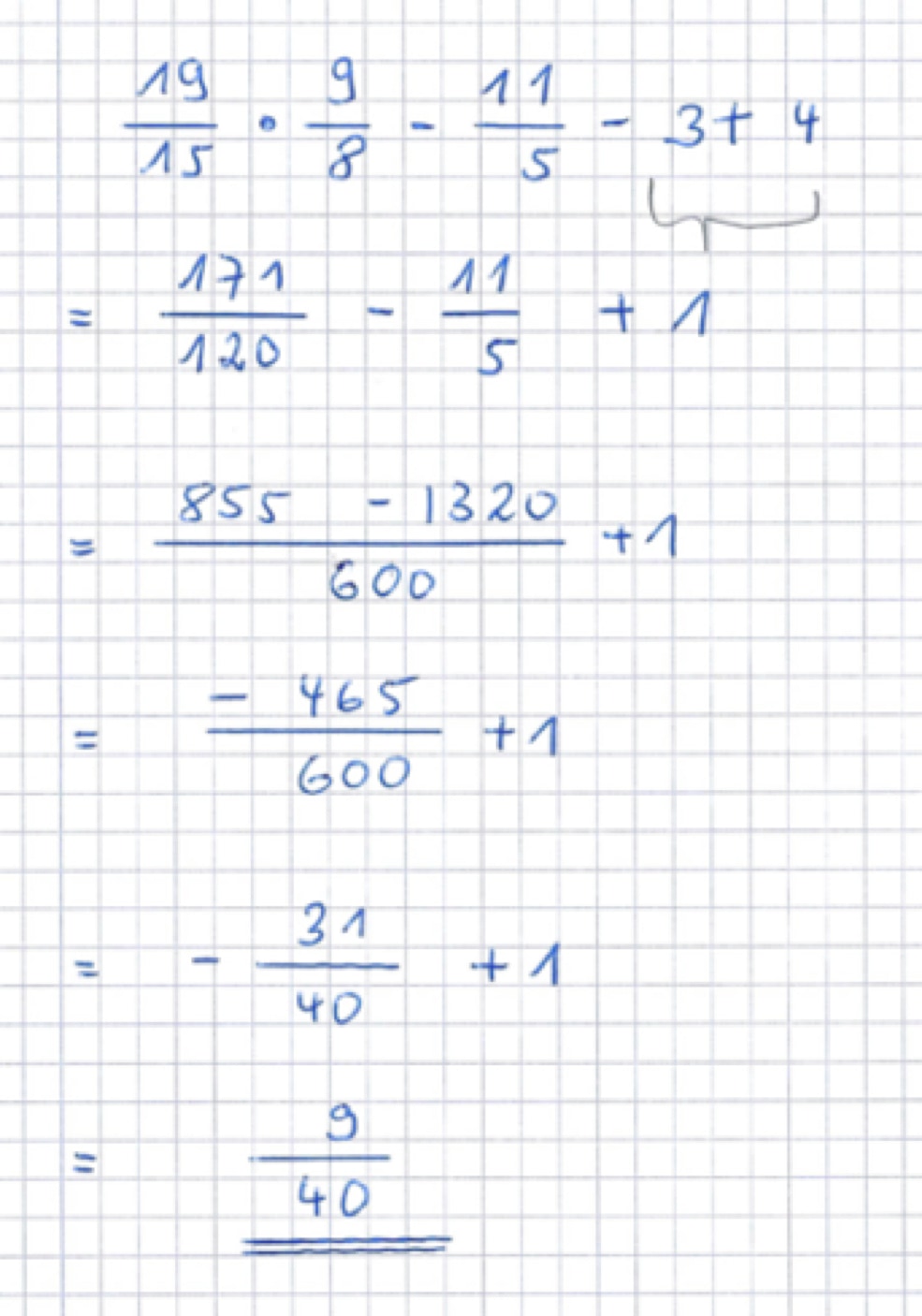
You can then use the symbol for entering the solution to switch to the screen for entering the results:
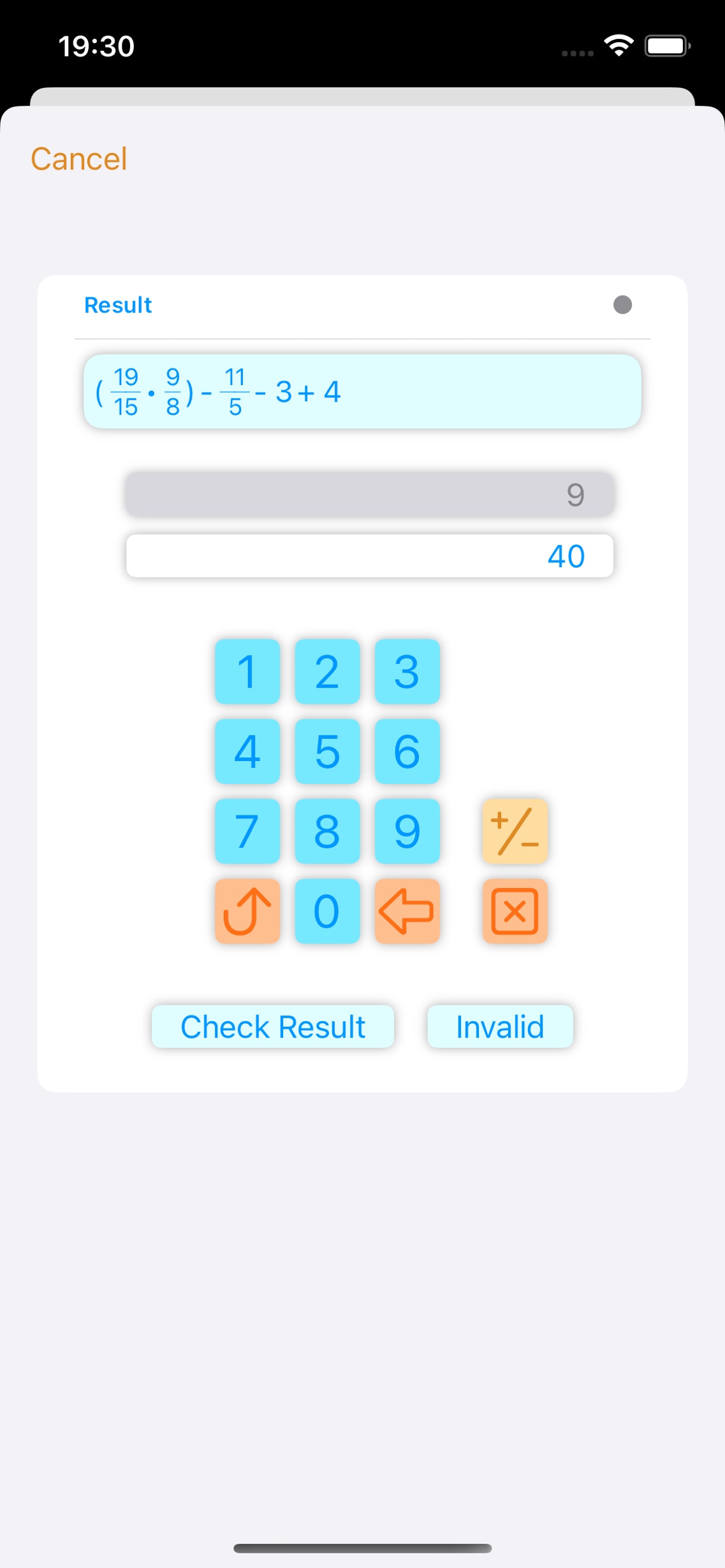
The result is recorded on a separate screen.
In the upper left corner there is Cancel, which allows you to return to the previous view with the exercises without taking any result check into account.
As long as no valid result has been entered, the only option is to declare the expression as invalid. This is the case, for example, with an expression that contains a division by zero.
The results are entered using the keys on the keyboard; the keys correspond to those in the Calculator or Expression mode. The meaning can be read again on the page about the user interface.
As soon as a valid result value has been recorded, the button to check the result also appears.
After checking the results, the entered result and, in the case of an error, the correct result are displayed:
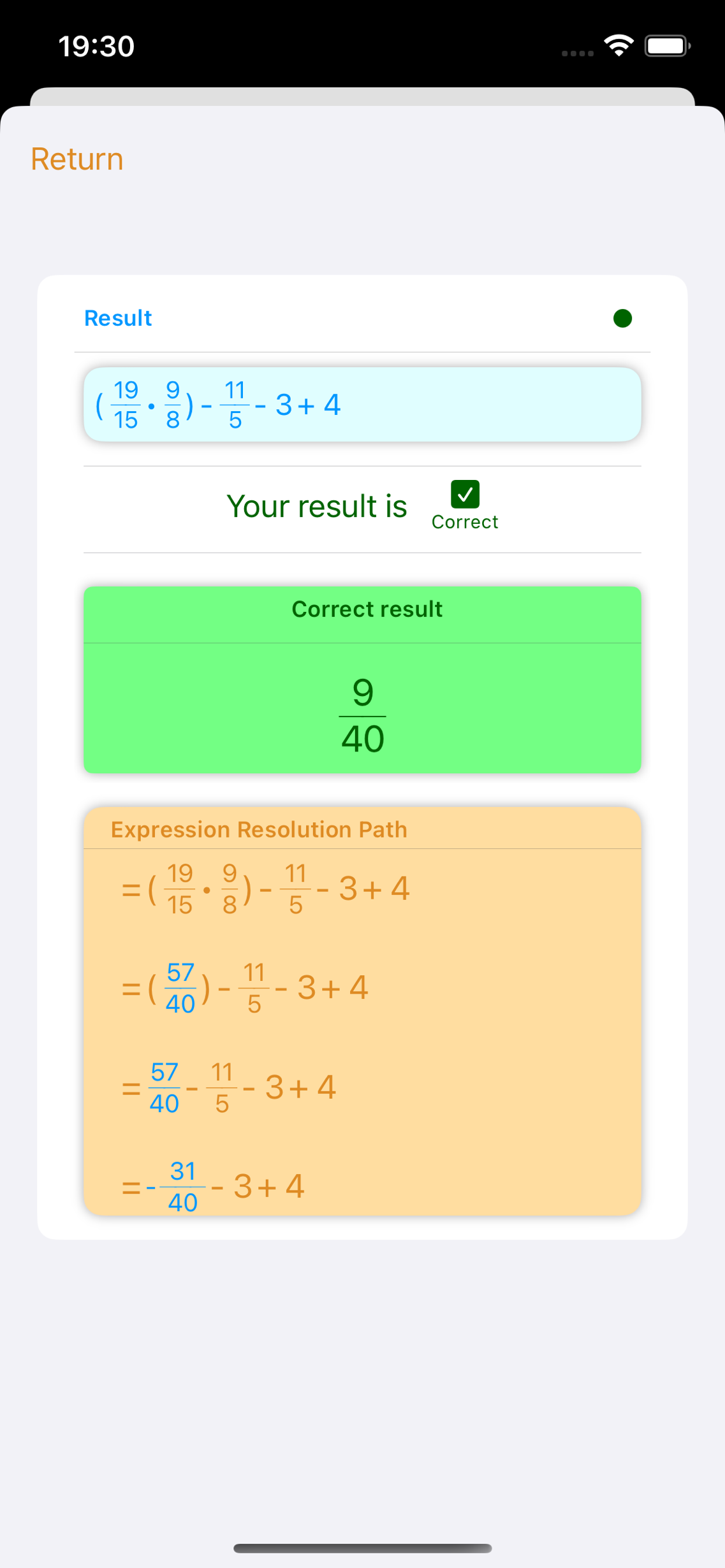
Once the result entry has been checked, the result evaluation has been completed and the value can no longer be changed.
The display changes from the result entry screen to the evaluation screen.
Return appears in the upper left corner. This allows you to jump back to the exercises.
The result indicator is located at the top right of the result card. This shows the evaluation result:
Result-Indicator

Result not yet captured.

Result is correct.

Result is correct, but not shortened.

Result is incorrect..
The results card first shows the exercises and the evaluation of the results - in the form of a result symbol and text as “Correct”, “Correct but not shortened” or “Incorrect”.
The result evaluation is additionally marked by the color green for “Correct”, yellow for “Correct, but not shortened” and red for “Incorrect”.
The entered result appears below and, if this is incorrect, the correct result.
Finally, the solution path is displayed.
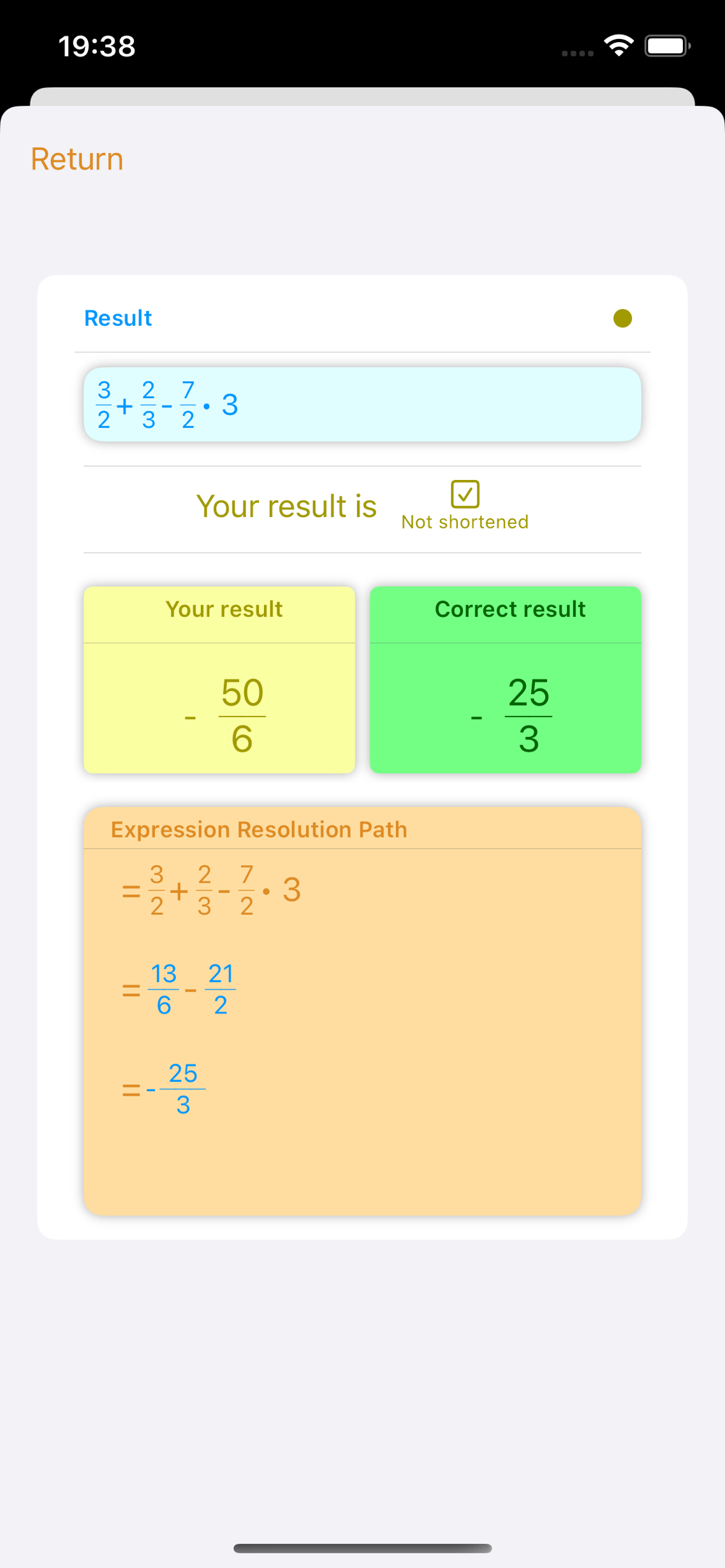
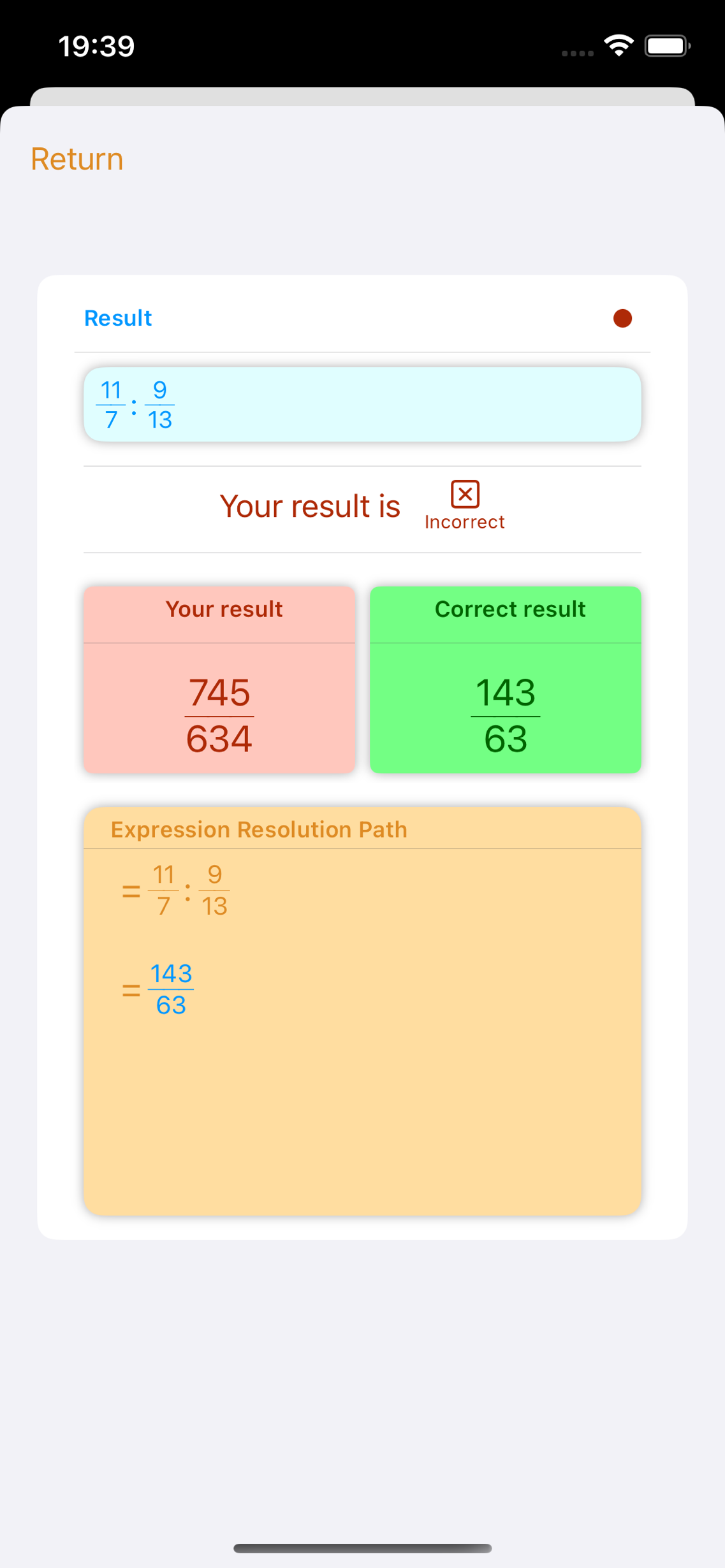
Las but not least, the evaluation for a result value that is correctly recorded as an irregular expression:
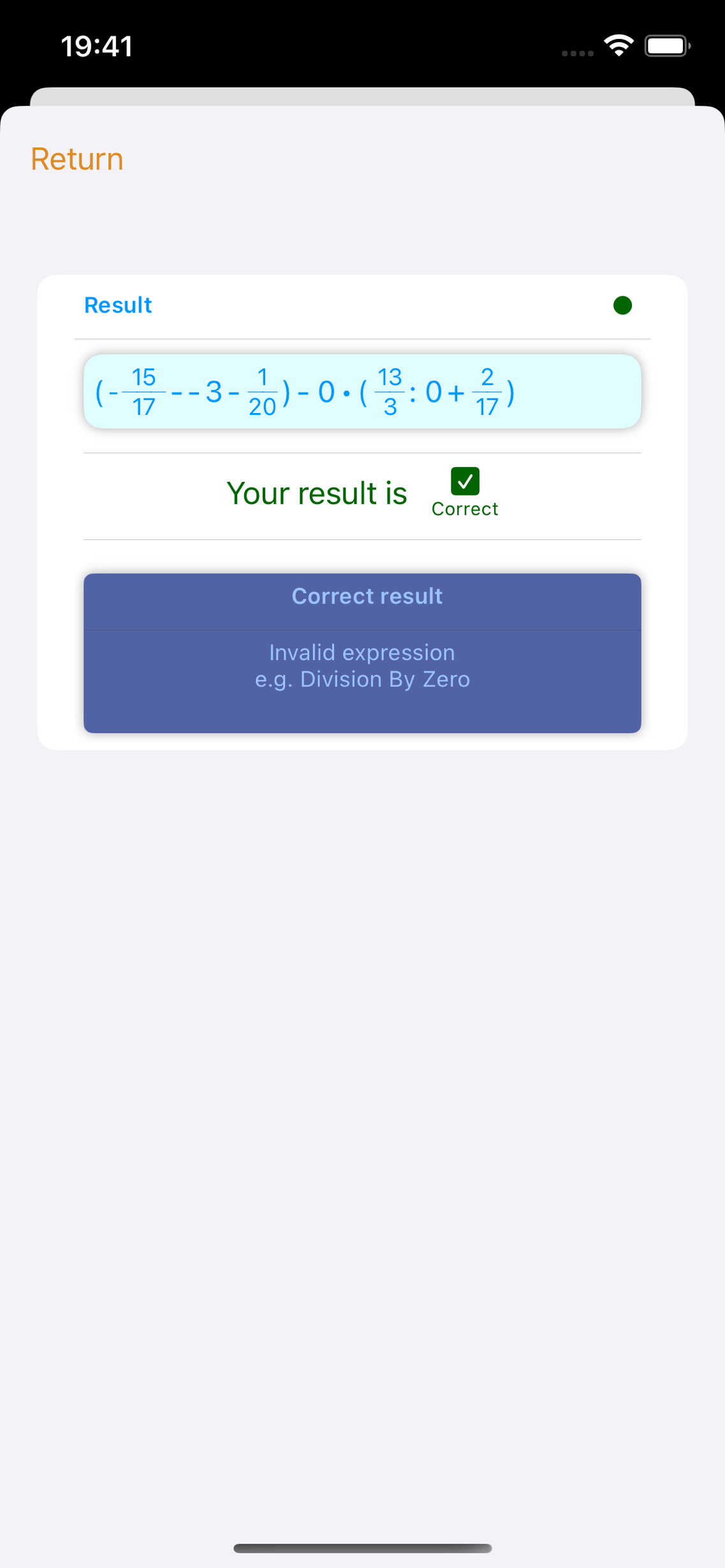
After „Check result”, the value entered counts for the evaluation. The results recording can no longer be canceled with “Cancel”.
With „Return” (top left) you can switch back to the list of exercises.
Back in the Exercises list,
Selecting a exercise from the list that has already been checked will switch back to the results evaluation display.
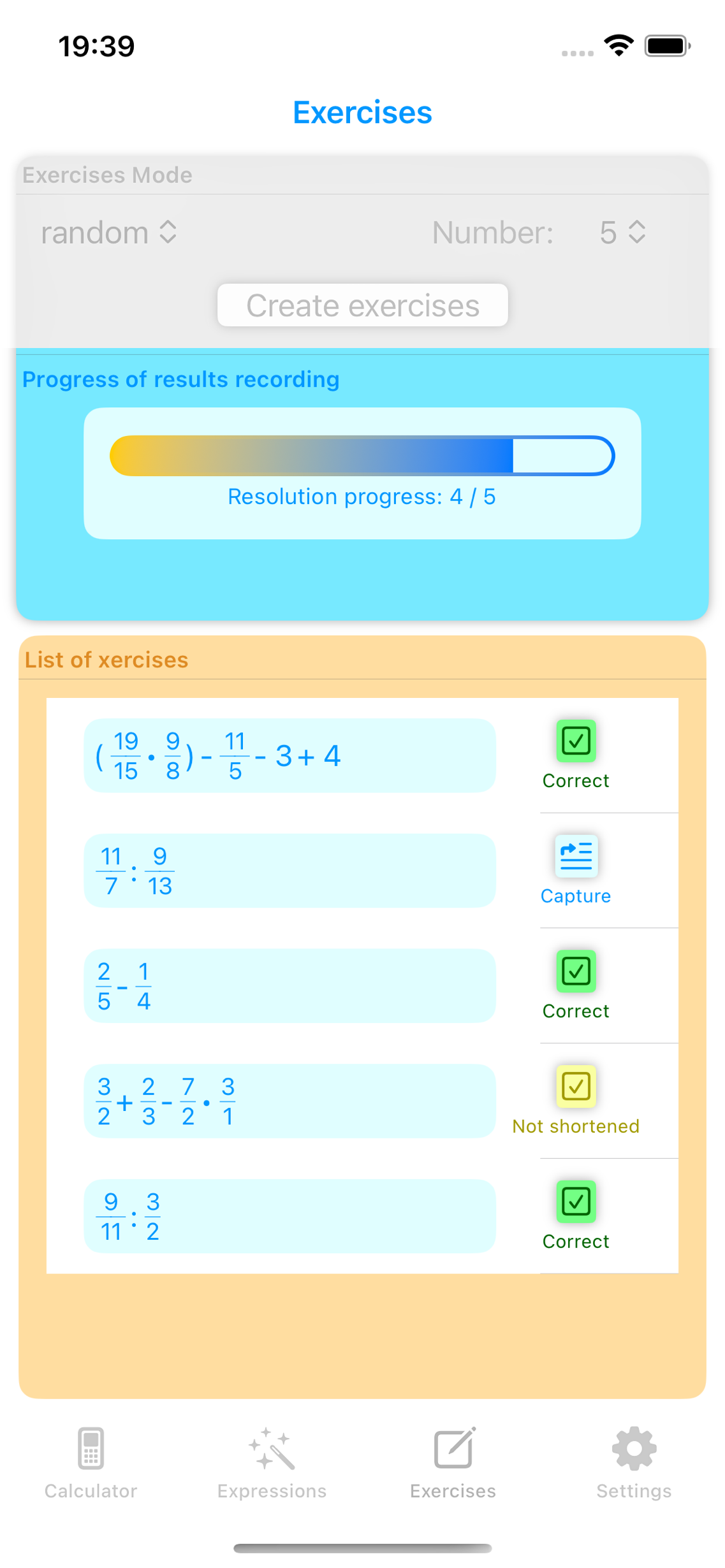
Once all exercises have been checked, the overall evaluation result gets displayed instead of the capture progress bar.
The result is shown as a color gradient from red to yellow to green and as a score in the form {points achieved} / {maximum points}.
For every exercise
The result color gradient represents the result as a percentage distribution. The color scale allows so an evaluation of the result achieved independent from the number of exercises:
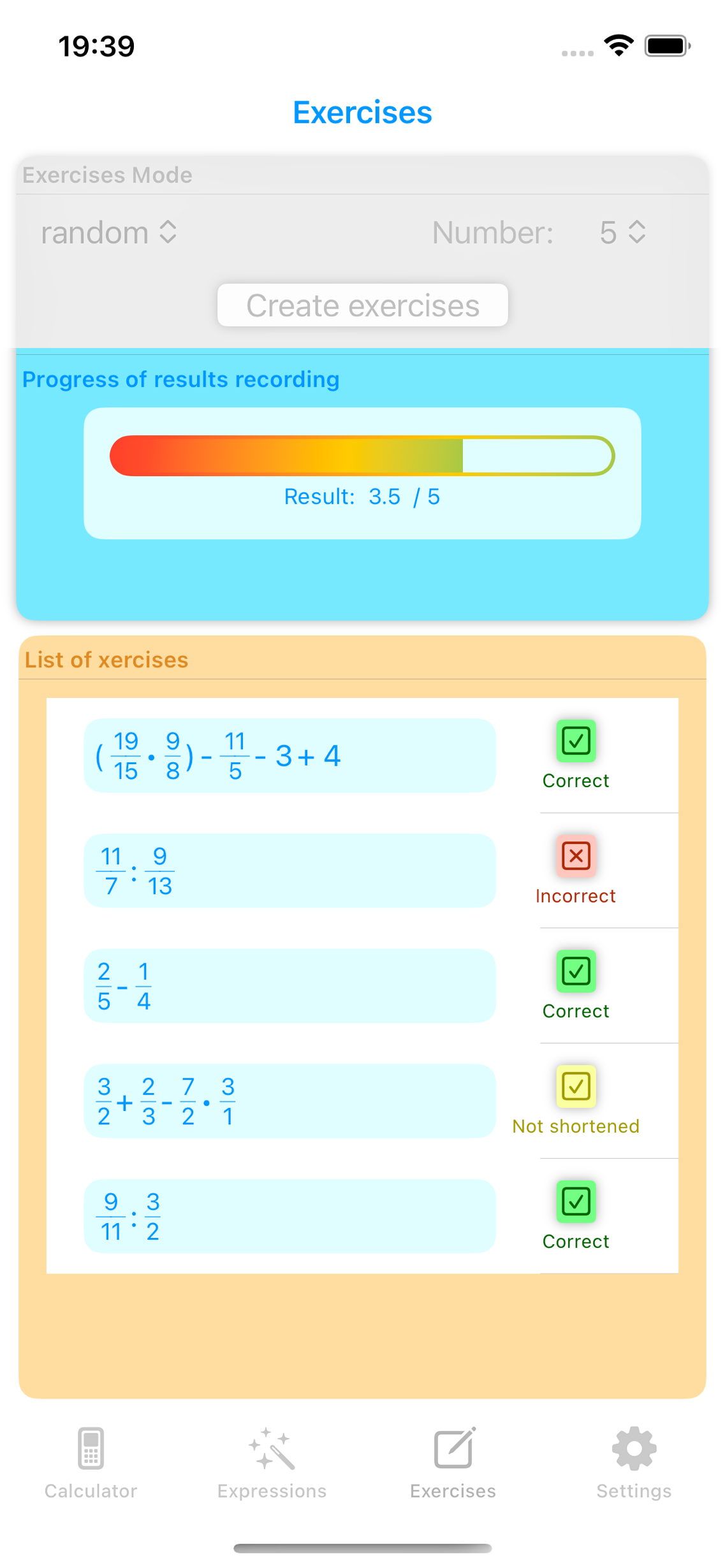
With „custom” exercises you get full control over the settings for generating exercises.
Attention:
If the configuration is unfavorable, exercises that make little sense are created, usually very long expressions with the result “invalid”.
If this is the case, the settings must be adjusted accordingly.
The settings for creating „custom” exercises provide you a powerful tool. The settings should not be done indiscriminately.
But don't worry, nothing can break, only parameters need to be adjusted in order to generate meaningful exercises.
After selecting „custom” the display changes:
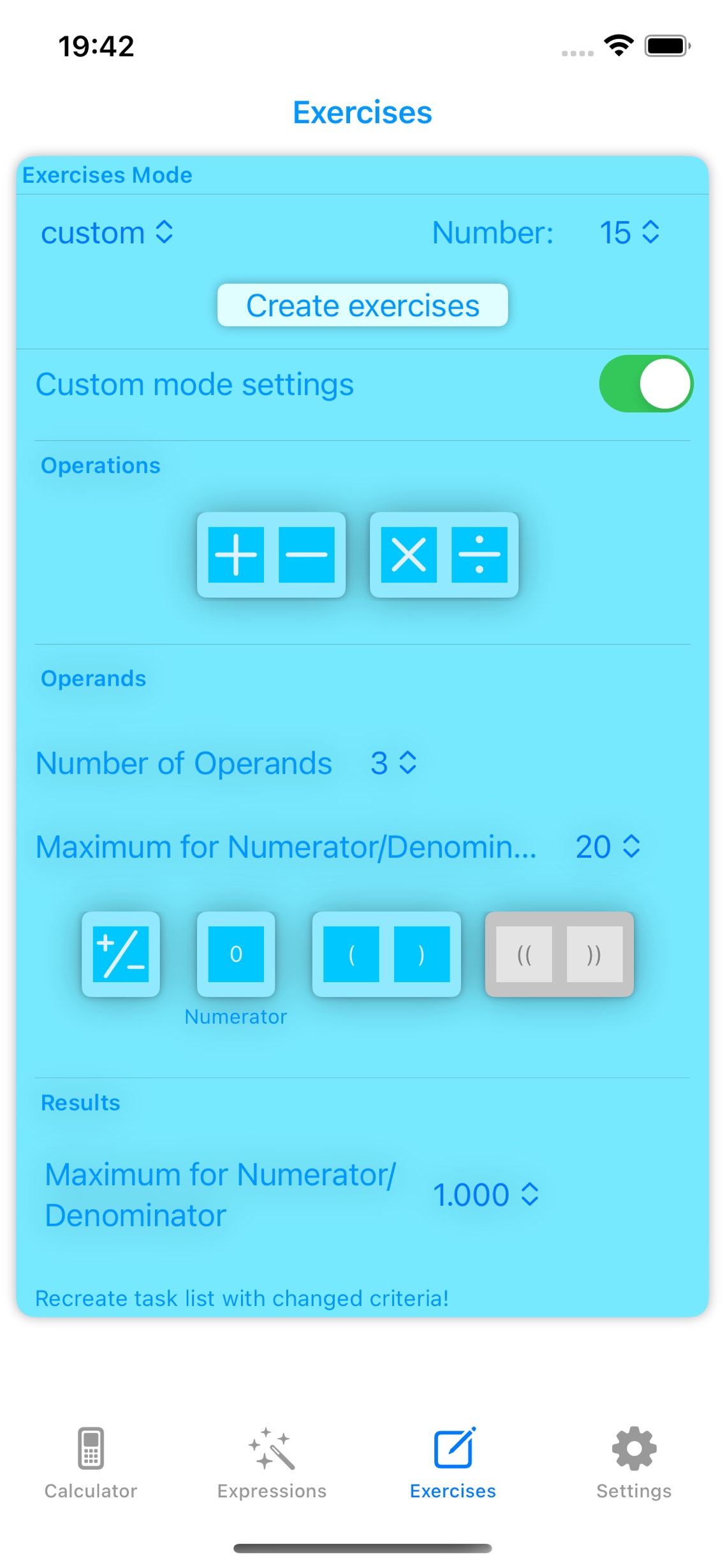
The following is an explanation of the individual setting options from top to bottom:

Use the switch to turn „custom settings” on and off
This means you can always switch back and forth between the exercises list and display of custom settings..
Operations
The operations settings determine which operations - i.e. dash and/or point calculations - should be used in the exercises.

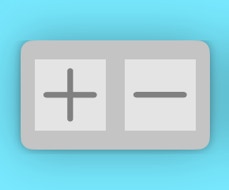
Dash Operations (plus, minus) on/off


Point Operations (multiply, divide) on/off
At least one of the two options must be set. Otherwise, a warning message appears.
Operands
First, the number of operands for an arithmetic expression can be specified.

If exercises with sub-expressions are selected, a sub-expression counts as one operand.
Each sub-expression can then consist of up to this number of operands either.
The maximum value for the numerator and denominator of an operand can also be specified:

With this definition, the level of difficulty of the exercises can be easily controlled. The larger the value, the more difficult the exercises usually become.
This value must always be at least one step lower than the maximum value for the denominator/numerator of the result. FracEx Calc enforces compliance with this rule.
The use of negative signs for operands is switched on or off with the following switch:.
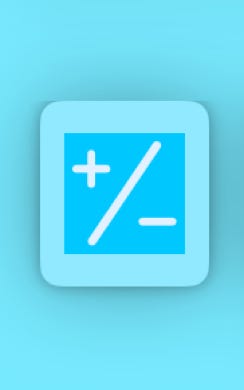
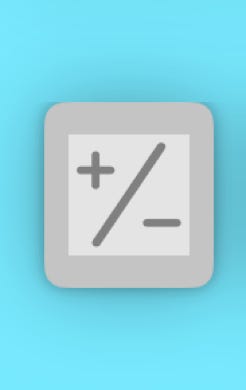
Negative Sign on/off
Turning off the use of negative signs is recommended initially for creating simpler exercises. With more experience, this switch is more likely to stay on.
The use of ‚0’ for the numerator can be set using the following switches:
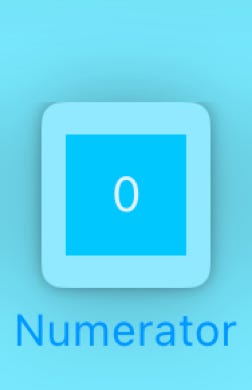
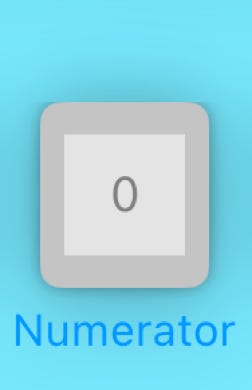
Numerator with zero on/off
The use of zero as a Numerator is more likely to be used for special training purposes when the understanding of how to deal with the value zero needs to be practiced. This might be usually set to off.
A sub-expression - i.e. a part of the expression that is set in parenthesis - is considered as one operand in the context of the associated expression. The sub-expression itself is then created again according to the custom settings, with the restriction that the number of operands in the sub-expression is randomly determined between 2 and the specified operand count.
In addition, there is the possibility of deeper nesting with additional sub-expressions within a sub-expression.

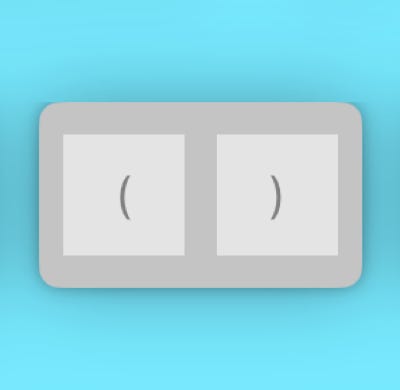
Sub-expressions
on/off
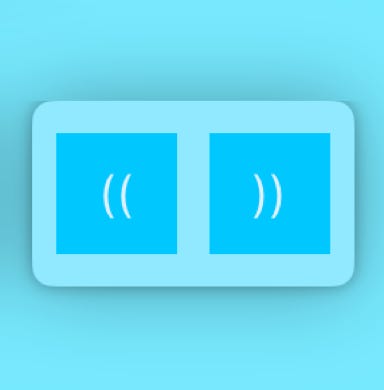
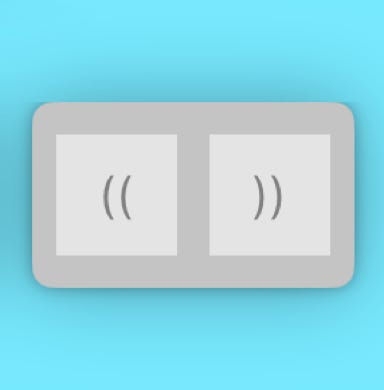
Nested sub-expressions on/off
Even if the FracEx Calc app is able to calculate expressions of any nesting depth, in the Exercises mode expressions are generated with a maximum nesting depth of three sub- expressions.
Remark:
Result
The maximum value for denominator and numerator of a result value for a created exercise can also be set:

If this value is defined too narrowly, FracEx Calc may not be able to generate meaningful exercises. This usually leads to invalid expressions, which are often very long.
If this is the case, either other custom settings should be adjusted or this option for the maximum value for the denominator and numerator of the result value should be increased.
Remark:
When setting the maximum values of denominator and numerator for operands and result values, FracEx Calc always forces this value to be set one level higher for results than for operands.
General configurations for the exercise mode are set on the settings page.
In addition to switching the Exercises Mode on and off as described at the beginning of this page, this includes setting the probabilities for certain options when creating Exercises.
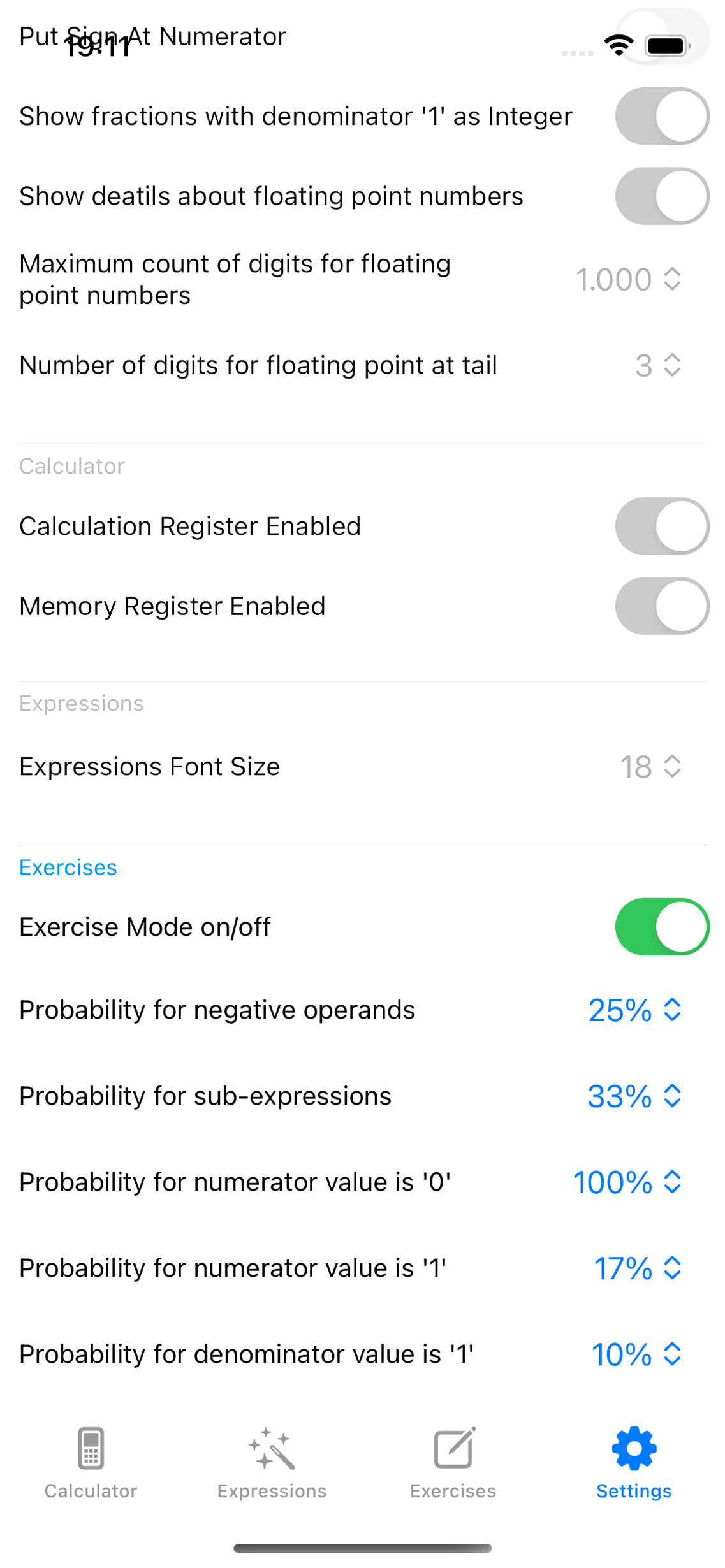
Input via the keyboard is not supported in version 1.1 in exercise mode.
The probability can be set for:
The following settings are an adjustment of the probability with which this value is generated as such for an exercise.
For example, if the value range for generation has a denominator between 0 and 20, then the probability of the value '0' without adjusting the frequency is 1 out of 21.
Now, with a frequency adjustment
Any adjustment factor below 100% reduces the frequency of the regular probability by the selected adjustment factor.
This allows you to adjust the frequency:
Remark:
An adjustment when '1' occurs by shortening generated operands is not taken into account, which can have a (small) influence on the frequency of ‚1‘ appearing as numerator or denominator.